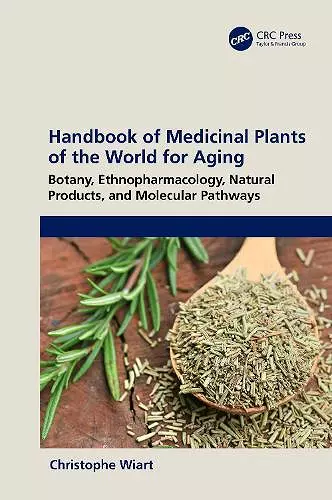Handbook of Medicinal Plants of the World for Aging
Botany, Ethnopharmacology, Natural Products, and Molecular Pathways
Format:Hardback
Publisher:Taylor & Francis Ltd
Published:11th Dec '23
Currently unavailable, and unfortunately no date known when it will be back

Handbook of Medicinal Plants of the World for Aging: Botany, Ethnopharmacology, Natural Products, and Molecular Pathways provides an unprecedented comprehensive overview of more than 100 plants used globally as medicine with the potential to prevent premature aging. This handbook covers the pathophysiology of aging from the molecular and cellular to the organ levels, as well as the current state of knowledge about the modes of action of natural products from plants on the pathophysiological pathways related to the (i) cardiovascular system and metabolism, (ii) central nervous system, (iii) kidneys, (iv) bones, (v) skin and hair, and (vi) immune system.
Medicinal plants are presented alphabetically. For each plant is indicated the botanical family, synonyms, and common names in English, French, German, Portuguese, Russian, and Spanish. For each plant, the reader will also □find the part used, active principles, medical history, contemporary medicinal uses, as well as pharmacological, clinical, and toxicological studies. The bibliographical references have been carefully selected for their relevance. This handbook is intended for medical doctors, nurses, pharmacists, dieticians, and nutritionists, as well as readers with interest in health food and herbs.
FEATURES
- Alphabetical presentation of over 100 medicinal plants and the pharmacological rationales for their uses for aging
- Discusses the medical history, current medicinal uses, and potential candidates for the prevention of premature aging
- Introduces the molecular mechanism of natural products on the pathophysiology of aging
- Contains a selection of bibliographic references
- A useful research tool for postgraduates, academics, and the pharmaceutical, herbal, or nutrition industries
Handbook of Medicinal Plants of the World for Aging: Botany, Ethnopharmacology, Natural Products, and Molecular Pathways presents comment sections that invite further research and reflection on the fascinating and timely subject of herbals for healthy aging. This is an ideal reference text for medicinal plant enthusiasts.
It gives me significant pleasure to write a foreword to Christophe Wiart’s latest compendium covering plant-related treatments for “premature ageing’. This is an area that has not been covered to any significant extent in translated treatises based on TCM (Traditional Chinese Medicine) or Ayurvedic-derived treatments (Indian subcontinent and contiguous areas). Ageing includes loss of cognition and includes dementia, which are frequently obvious to relatives of the “patient” and have been treated for centuries in many parts of the world.
This treatise covers the areas that “modern-day” natural product chemists and pharmacognosists would search in order to identify the active principles involved in the “treatment modalities” covered in the text. He has used indigenous lore to identify the plant(s) and/or their components and subsequent treatment, covering over 100 medicinal plants. What is of definite utility is the listing of the different names ascribed to a plant depending upon the sources of the information. This is a point that is frequently overlooked when describing a medicinal plant, since cross-referencing the name(s) used in different languages permits one to search current databases for information.
Another “plus” is his linkage of identified plant entities to information as to their “formal toxicities” which in some cases link-back to identified chemical entities. This part of the overall dataset should not stop any scientific work on the components that are described, since today, methods of delivery of toxic agents are well defined and used.
Therefore, I definitely recommend this handbook to anyone who is interested in potential treatments for premature ageing, be they scientific or medical professionals or people who are interested in the topic for general interest.
David J. Newman, DPhil
(Retired Chief, Natural Products Branch, National Cancer Institute, NIH, USA)
ISBN: 9781032293974
Dimensions: unknown
Weight: 453g
294 pages